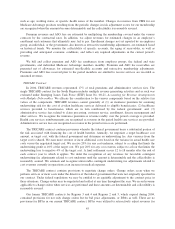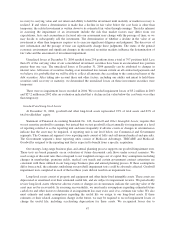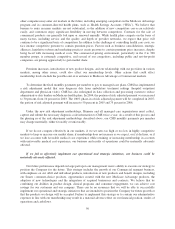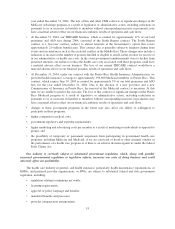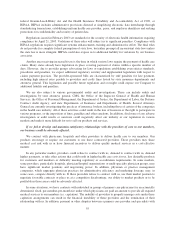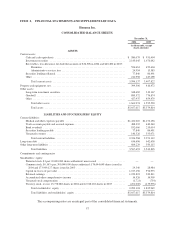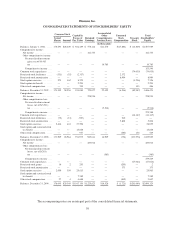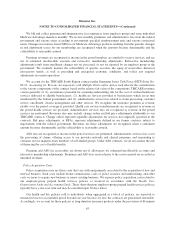Humana 2004 Annual Report Download - page 64
Download and view the complete annual report
Please find page 64 of the 2004 Humana annual report below. You can navigate through the pages in the report by either clicking on the pages listed below, or by using the keyword search tool below to find specific information within the annual report.• member disclosure;
• approval of entry, withdrawal or re-entry into a state or market;
• premium rates; and
• periodic examinations by state and federal agencies.
State regulations require our licensed, operating subsidiaries to maintain minimum net worth requirements
and restrict some investment activities. Additionally, those regulations restrict the ability of our subsidiaries to
make dividend payments, loans, loan repayments or other payments to us.
In recent years, significant federal and state legislation affecting our business has been enacted. State and
federal governmental authorities are continually considering changes to laws and regulations applicable to us and
are currently considering regulations relating to:
• mandatory benefits and products;
• rules tightening time periods in which claims must be paid;
• medical malpractice reform;
• defining medical necessity;
• health insurance access;
• provider compensation and contract language;
• disclosure of provider fee schedules and other data about payments to providers, sometimes called
transparency;
• product flexibility and use of innovative technology;
• disclosure of provider quality information;
• health plan liability to members who fail to receive appropriate care;
• disclosure and composition of physician networks;
• formation of regional/national association health plans for small employers;
• adding further restrictions and administrative requirements on the use, retention, transmission,
processing, production and disclosure of personally identifiable health information;
• physicians’ ability to collectively negotiate contract terms with carriers, including fees; and
• mental health parity.
All of these proposals could apply to us.
There can be no assurance that we will be able to continue to obtain or maintain required governmental
approvals or licenses or that legislative or regulatory change will not have a material adverse effect on our
business. Delays in obtaining or failure to obtain or maintain required approvals could adversely affect our
revenue or the number of our members, increase costs or adversely affect our ability to bring new products to
market as forecasted.
The National Association of Insurance Commissioners, or NAIC, has adopted risk-based capital
requirements, also known as RBC, which is subject to state-by-state adoption and to the extent implemented, sets
minimum capitalization requirements for insurance and HMO companies. The NAIC recommendations for life
insurance companies were adopted in all states and the prescribed calculation for HMOs has been adopted in
most states in which we operate. The HMO rules may increase the minimum capital required for some of our
subsidiaries.
The use of individually identifiable data by our business is regulated at federal and state levels. These laws
and rules are changed frequently by legislation or administrative interpretation. Various state laws address the
use and maintenance of individually identifiable health data. Most are derived from the privacy provisions in the
54



